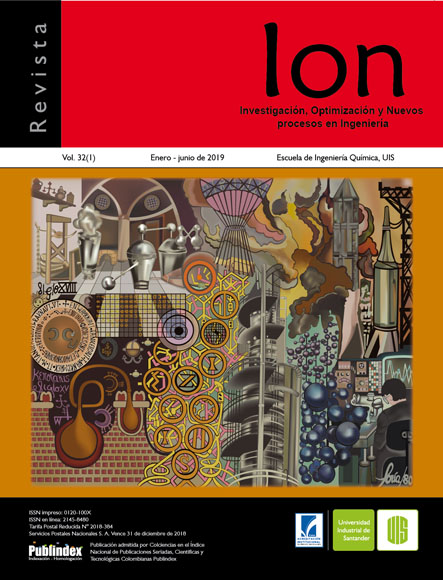Determination and statistical analysis of the composition of the gases produced in an Enhanced Oil Recovery Pilot
Published 2019-09-03
Keywords
- Air injection,
- Gas Chromatography,
- extra heavy oil,
- Enhanced Oil Recovery.
How to Cite
Abstract
The oil industry in Colombia has the challenge of exploiting deposits with heavy and extra-heavy oil. For this reason, Enhanced Oil Recovery methods (EOR) have been implemented in the country, looking for high production rates. Air injection is one of the EOR methods that allows to achieve high production rates. The Air Injection Pilot (PIAR) at Chichimene (Meta) is a pioneer in the world for implementing this method in a reserve of extra heavy oil (API <10) in a high depth. The monitoring of the physicochemical properties of the fluids generated during this process helps to ensure the correct operational functioning of the pilot. In this work, the gas composition from 16 wells located in the pilot area was determined by gas chromatography (GC). Methane was found mainly (68.5 ± 7.1), followed by CO2 (11.4 ± 5.6) and N2 (6.7 ± 4.2). The composition of the gases was dissimilar throughout the area, so Principal Component Analysis (PCA) and Cluster Analysis (CA) were made to assess the similarities between the gases of the wells. As a result, the wells were organized into three groups by similarity: a group with the highest methane levels (75.8%); the second group with N2 (11.9%); and a third group with the highest CO2 values (20.1%), consisting of three wells. These groups were plotted on a map and it was noted that they are in defined areas within the pilot.
Downloads
References
[2] Peñuela Muñoz JH. Crudos pesados: la realidad del sector hidrocarburos de Colombia. Rev. VirtualPRO. 2017;(184):3.
[3] Guo K, Li H, Yu Z. In-situ heavy and extra-heavy oil recovery: A review. Fuel. 2016;185:886-902.
[4] Mahinpey N, Ambalae A, Asghari K. In situ combustion in enhanced oil recovery (EOR): a review. Chem. Eng. Commun. 2007;194:995-1021.
[5] Gutierrez M, Bonilla F, Gil L, Parra W, Campo P, Orozco A, et al. Chemical stimulation pilot at a heavy-oil field: key considerations, workflow, and results. En: SPE Canada heavy oil technical conference; 2017 feb 15-16; Calgary, Alberta, Canada: Society of petroleum engineers; 2017.
[6] Trujillo M, Delgadillo C, Niz-Velásquez E, Claro Y, Rodriguez E, Rojas R. Reducing uncertainty at the chichimene in situ combustion pilot by means of a nitrogen connectivity test. En: SPE Improved oil recovery conference; 2018 Abr 14-18; Tulsa, Oklahoma, USA: Society of petroleum engineers; 2018. p. 1-16.
[7] Dayal HS, Pandey V, Mitra S, Bhushan BV, Bhandari AC, Dwivedi MM. Monitoring of in-situ combustion process in southern part of balol field through analysis of produced fluids. En: SPE Heavy oil conference and exhibition; 2010 dic 12-14; Kuwait (ciudad), Kuwait: Society of petroleum engineers; 2011.
[8] Bojes JM, Wright GB. Application of fluid analyses to the operation of an in situ combustion pilot. J. Can. Pet. Technol. 1989;28(1):106-19.
[9] Panait-Patica A, Serban D, Ilie N, Pavel L, Barsan N. Suplacu de barcau field-a case history of a successful in-situ combustion exploitation. En: SPE Europec/EAGE annual conference and exhibition; 2006 jun 12-15; Viena, Austria: Society of petroleum engineers; 2006.
[10] Gil E, Quintero NM, Rojas LA, Fuenmayor M, Farouq Ali S. Monitoring and optimization of an in-situ combustion pilot applying STAR™ technology. En: SPE Canada heavy oil technical conference; 2015 Jun 9-11; Calgary, Alberta, Canada: Society of petroleum engineers; 2015. p. 1-15.
[11] Guarin Arenas F, Garcia CA, Diaz Prada CA, Cotes Leon EDJ, Santos N. A new inflow model for extra-heavy crude oils: case study chichimene field, Colombia. En: SPE Latin American and Caribbean petroleum engineering conference; 2009 dic 1-3; Lima, Peru: Society of petroleum engineers; 2010.
[12] Faramawy S, Zaki T, Sakr AA. Journal of natural gas science and engineering natural gas origin, composition, and processing: a review. J. Nat. Gas Sci. Eng. 2016;34:34-54.
[13] Ferreira JEV, Pinheiro MTS, dos Santos WRS, Maia RDS. Graphical representation of chemical periodicity of main elements through boxplot. Educ. Química. 2016;27(3):209-16.
[14] University of Otago. A tutorial on Principal Components Analysis Introduction. Dunedin, Otago, Nueva Zelanda: Smith LI; 2002.
[15] Rodriguez E, Ordonez A, Comas JC, Trujillo Portillo ML, Belgrave JDM. A framework for consolidating air injection experimental data. En: SPE Latin America and Caribbean petroleum engineering conference; 2011 abr 16-18; Ciudad de Mexico, Mexico: Society of petroleum engineers; 2012. p. 1-9.
[16] Barrero D, Pardo A, Vargas CA, Martínez JF. Colombian sedimentary basins: Nomenclature, boundaries and petroleum geology, a new proposal. INH. 2007;1:92.

